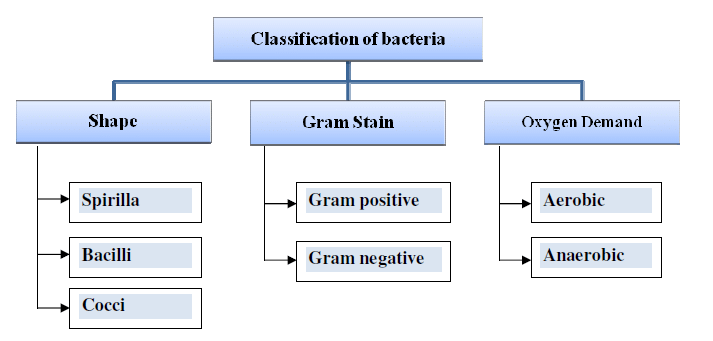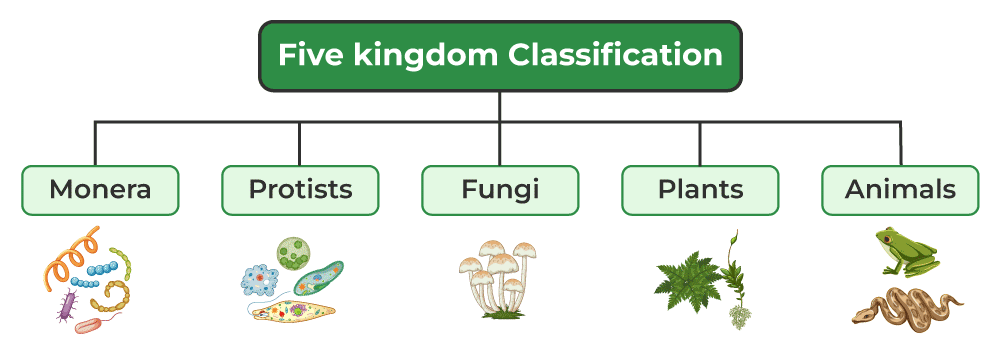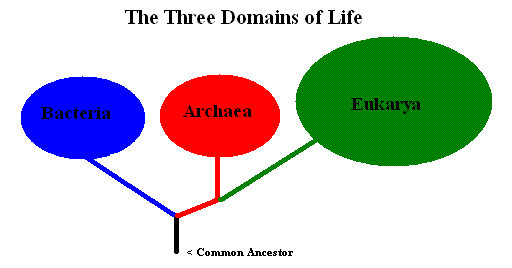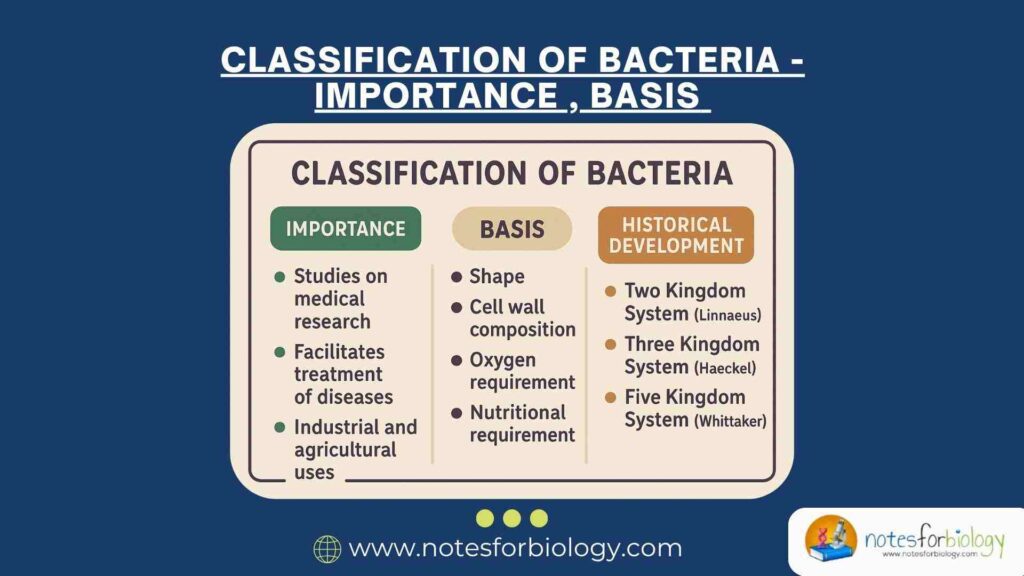Bacteria are microscopic, unicellular prokaryotic organisms that exhibit an incredible diversity in shape, size, structure, and metabolic activity. They are among the earliest life forms to have appeared on Earth and inhabit virtually every environment, ranging from soil and water to the human body and extreme environments such as hot springs and deep-sea vents. Understanding bacterial classification is fundamental to microbiology, as it provides insights into their relationships, physiology, pathogenicity, and ecological roles.
This content presents a detailed and structured account of the classification of bacteria based on various criteria, as well as its significance in biological research and medical sciences.
Summary of Bacterial Classification
- Bacterial classification is the systematic grouping of bacteria based on characteristics like shape, cell wall composition, oxygen requirement, nutrition, temperature, pH preference, and genetic features.
- Modern classification relies heavily on molecular techniques, especially 16S rRNA gene sequencing, to determine evolutionary relationships and improve accuracy over traditional methods.
- This classification is essential in medicine, industry, and environmental studies for identifying bacterial species, diagnosing diseases, and utilizing bacteria in various applications.
Table of Contents
Definition of Bacterial Classification
Bacterial classification is the systematic arrangement of bacteria into categories or groups based on similarities and differences in their characteristics. These characteristics may be morphological, physiological, biochemical, genetic, or ecological in nature. The purpose of classification is to organize the immense diversity of bacterial species into an understandable framework, facilitating identification, study, and communication within the scientific community.
Importance of Bacterial Classification
Bacterial classification holds great importance in microbiology, medicine, agriculture, and industry. Its significance can be explained under several points:
Organizing Biological Knowledge
Classification helps organize and systematize the vast diversity of bacteria, making it easier for scientists to study and understand their structure, function, and ecology.
Identification and Diagnosis
Accurate classification aids in the identification of bacteria, which is crucial in diagnosing bacterial infections and choosing appropriate treatments.
Industrial and Agricultural Applications
Many bacteria are beneficial in industries like food processing, medicine production, and agriculture. Classification helps select specific bacterial strains for desired uses such as antibiotic production, nitrogen fixation, and waste treatment.
Understanding Evolutionary Relationships
Classification reveals the evolutionary relationships between different bacterial groups and between bacteria and other organisms, helping scientists trace their origin and development.
Supporting Research and Biotechnology
Bacterial classification provides a foundation for research in genetics, biotechnology, and molecular biology, enabling the development of new medicines, vaccines, and genetically engineered products.
Historical Development of Bacterial Classification
The history of bacterial classification evolved through several stages, beginning with simple observations and advancing to modern genetic analysis:
Early Observations
In the 17th century, Antonie van Leeuwenhoek was the first to observe bacteria using a simple microscope. At that time, bacteria were grouped broadly as “animalcules” without proper classification.
Traditional Classification
In the 19th century, bacteria were classified based on their shape and movement. Names like cocci, bacilli, and spirilla were introduced during this period.
Gram Staining Method
In 1884, Christian Gram developed the Gram staining technique, which divided bacteria into Gram-positive and Gram-negative groups based on cell wall structure. This remains a fundamental method in bacterial classification.
Bergey’s Manual
In the early 20th century, David Hendricks Bergey published Bergey’s Manual of Determinative Bacteriology, a comprehensive guide for classifying bacteria based on morphology, physiology, and staining characteristics.
Molecular Classification
In the late 20th century, advances in molecular biology introduced classification based on genetic analysis, particularly ribosomal RNA (rRNA) sequencing. This method provided a clearer understanding of bacterial relationships and led to the division of prokaryotes into Bacteria and Archaea.
Basis of Bacterial Classification

This section introduces the different criteria used to classify bacteria, each discussed under separate subheadings.
Classification Based on Shape (Morphology)
One of the earliest and simplest methods of classifying bacteria involves their morphological characteristics, particularly cell shape. Bacteria are typically grouped into several basic forms, including cocci (spherical), bacilli (rod-shaped), spirilla (spiral-shaped), and vibrios (comma-shaped). This morphological distinction provides an initial step in bacterial identification and classification.
Classification Based on Cell Wall Composition
Another important criterion is the structural composition of the bacterial cell wall, which is revealed through the Gram staining technique. Bacteria are classified as Gram-positive or Gram-negative based on their ability to retain the crystal violet stain during this procedure. Gram-positive bacteria possess a thick peptidoglycan layer in their cell wall, whereas Gram-negative bacteria have a thinner peptidoglycan layer and an additional outer membrane composed of lipopolysaccharides. This classification is critical in determining bacterial pathogenicity and antibiotic susceptibility.
Classification Based on Flagella Arrangement
The arrangement and number of flagella on bacterial cells also serve as a basis for classification. Some bacteria lack flagella altogether, while others possess one or multiple flagella arranged in various patterns. Monotrichous bacteria have a single flagellum at one end, lophotrichous bacteria bear a tuft of flagella at one end, amphitrichous bacteria have flagella at both ends, and peritrichous bacteria possess flagella distributed over the entire cell surface. This characteristic influences bacterial motility and behavior in different environments.
Classification Based on Spore Formation
Certain bacteria have the ability to form endospores — highly resistant, dormant structures that enable survival in harsh conditions such as extreme heat, desiccation, or exposure to disinfectants. Bacteria are classified based on their capacity to produce spores, with genera such as Bacillus and Clostridium known for spore formation. This trait is significant in clinical microbiology for identifying pathogenic species capable of surviving adverse conditions.
Classification Based on Oxygen Requirement
Bacteria differ in their requirement and tolerance for molecular oxygen, and this property is used as a classification criterion. Aerobic bacteria require oxygen for growth, while anaerobic bacteria grow in the absence of oxygen. Facultative anaerobes can grow in both the presence and absence of oxygen, while microaerophilic bacteria require low concentrations of oxygen for growth. Obligate anaerobes, on the other hand, are killed in the presence of oxygen. Understanding this classification helps in selecting appropriate culture conditions for bacterial isolation and study.
Classification Based on Nutritional Requirements
Bacteria are also classified according to their nutritional requirements and modes of obtaining energy and carbon. Autotrophic bacteria synthesize their organic compounds from inorganic sources, while heterotrophic bacteria require preformed organic compounds for growth. Further distinctions include photoautotrophs, which use light energy, and chemoautotrophs, which derive energy from chemical reactions. This classification is essential in ecological studies and industrial microbiology.
Classification Based on Temperature Preference
Temperature tolerance varies among bacterial species, leading to classification based on optimal growth temperatures. Psychrophilic bacteria thrive at low temperatures ranging from 0°C to 20°C. Mesophilic bacteria grow best at moderate temperatures between 20°C and 45°C, while thermophilic bacteria prefer high temperatures above 45°C. Hyperthermophilic bacteria are adapted to extreme heat, often exceeding 80°C. This classification is valuable in food safety, environmental microbiology, and biotechnology.
Classification Based on pH Preference
Bacteria exhibit different pH preferences for optimal growth. Acidophilic bacteria grow in acidic environments with a pH below 5.5, neutrophilic bacteria prefer neutral pH around 7.0, and alkaliphilic bacteria thrive in alkaline conditions with a pH above 8.5. This classification informs the design of culture media and aids in identifying environmental isolates.
Classification Based on Genetic and Molecular Characteristics
Advancements in molecular biology have introduced genetic sequencing as a highly precise method for bacterial classification. Techniques such as 16S rRNA gene sequencing analyze conserved regions of bacterial DNA, providing insights into evolutionary relationships. This approach has led to the establishment of phylogenetic trees that reflect true genetic affiliations rather than superficial similarities.
Modern Taxonomic Systems in Bacterial Classification
This section discusses the major taxonomic frameworks historically and presently used to classify bacteria.
The Five Kingdom Classification

Traditionally, bacteria were placed within the Kingdom Monera under the Five Kingdom Classification proposed by Robert Whittaker. This system grouped all prokaryotic organisms, including bacteria and cyanobacteria, separately from eukaryotic organisms. While this classification provided a broad framework, it was limited in its ability to reflect genetic and evolutionary relationships.
The Three Domain System

Modern bacterial taxonomy predominantly follows the Three Domain System proposed by Carl Woese, based on molecular phylogenetics. This system divides all living organisms into three domains: Bacteria, Archaea, and Eukarya. The domain Bacteria includes all true bacteria, characterized by prokaryotic cell structure, peptidoglycan-containing cell walls, and unique genetic sequences. This classification provides a more accurate reflection of evolutionary history and relationships.
Examples of Bacterial Genera Based on Classification Criteria
The classification criteria discussed above can be illustrated through representative bacterial genera. Cocci-shaped bacteria include genera such as Staphylococcus, Streptococcus, and Micrococcus. Rod-shaped bacilli include Escherichia, Bacillus, and Clostridium. Spiral forms are represented by Spirillum and Treponema. Gram-positive bacteria encompass Bacillus, Clostridium, and Staphylococcus, while Gram-negative bacteria include Escherichia, Salmonella, and Pseudomonas. These examples demonstrate the practical application of classification systems in identifying and studying bacterial species.
Conclusion
The classification of bacteria is a foundational aspect of microbiology, enabling the organization, identification, and study of a diverse group of microscopic organisms. Early classification systems based on morphology have evolved to incorporate biochemical, physiological, ecological, and genetic characteristics, resulting in more comprehensive and accurate taxonomic frameworks. Modern classification relies heavily on molecular techniques, particularly genetic sequencing, which reveals true evolutionary relationships among bacteria. Understanding bacterial classification is vital not only for academic research but also for medical, industrial, and environmental applications, highlighting the immense significance of this discipline in contemporary biology.
Frequently Asked Questions (FAQ)
Why is bacterial classification important in microbiology?
Bacterial classification helps in identifying, naming, and grouping bacteria, which is crucial for diagnosing diseases, selecting treatments, and studying bacterial roles in health, industry, and the environment.
What is the difference between Gram-positive and Gram-negative bacteria?
Gram-positive bacteria have a thick peptidoglycan cell wall that retains the violet stain, while Gram-negative bacteria have a thin peptidoglycan layer and an outer membrane, appearing pink after staining.
How do bacteria differ based on oxygen requirements?
Some bacteria need oxygen to grow (aerobic), some grow without it (anaerobic), others can survive with or without oxygen (facultative anaerobes), and a few need very little oxygen (microaerophiles).
Related Contents
Meristematic Tissue: Characteristics, Types, and Functions
Bacterial Spore: Structure, Types, Sporulation and Germination




